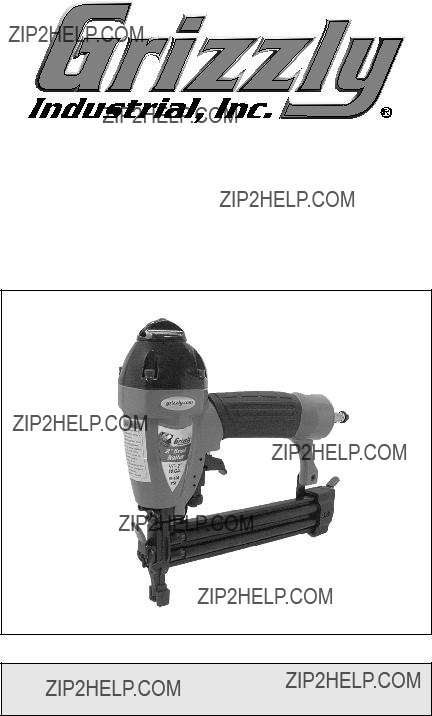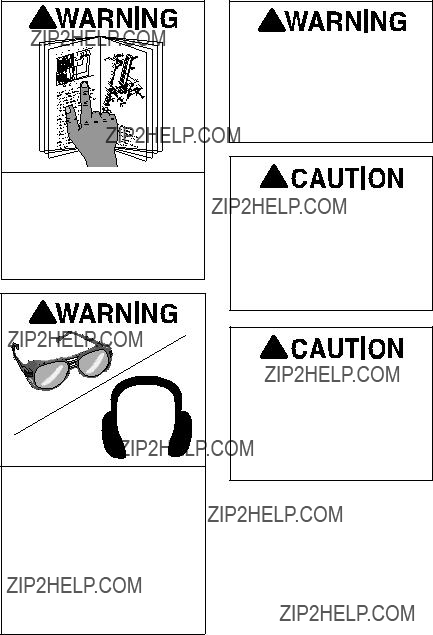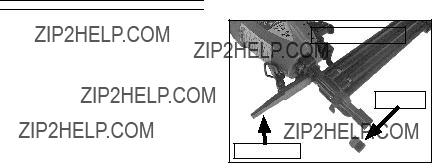MODEL T21347
18 GAUGE 2" NAILER KIT
OWNER'S MANUAL
Copyright ?? MARCH, 2009 By Grizzly Industrial, Inc.
Warning: No portion of this manual may be reproduced in any shape or form without the written approval of Grizzly Industrial, inc.
#TS11625 printed in CHINA
SAFETY
For Your Own Safety Read Instruction Manual
Before Operating This Equipment
The purpose of safety symbols is to attract your attention to possible hazard- ous conditions. This manual uses a series of symbols and signal words which are intended to convey the level of importance of the safety messages. The progression of symbols is described below. Remember that safety messages by themselves do not eliminate danger and are not a substitute for proper accident prevention measures.
Indicates an imminently hazardous situation which, if not avoided, WILL result in death or serious injury.
Safety Instructions For Pneumatic Tools
1.KEEP ALL SAFETY DEVICES IN PLACE and in working order.
2.REMOVE ADJUSTING KEYS AND WRENCHES. Form habit of check- ing to see that keys and adjusting wrenches are removed from tool before operation.
3.KEEP WORK AREA CLEAN. Cluttered areas and benches invite accidents.
4.DO NOT USE IN DANGEROUS ENVIRONMENT. Do not use pneu- matic tools in damp or wet loca- tions, or where any flammable or noxious fumes may exist. Keep work area well lighted.
5.KEEP CHILDREN AND VISITORS AWAY. All children and visitors should be kept at a safe distance from work area.
6.MAKE WORKSHOP CHILD PROOF by locking your shop and shutting off air valves.
7.DO NOT FORCE TOOL. It will do the job better and safer at the rate for which it was designed.
8.USE THE RIGHT TOOL. Do not force tool or attachment to do a job for which it was not designed.
9.DO NOT USE UNDER THE
INFLUENCE OF DRUGS OR
ALCOHOL.
Safety Instructions For Pneumatic Tools
10.USE PROPER AIR HOSE for the tool. Make sure your air hose is in good condition and is long enough to reach your work without stretching.
11.WEAR PROPER APPAREL. Do not wear loose clothing, gloves, neck- ties, rings, bracelets, or other jew- elry which may get caught in moving parts. Non-slip footwear is recom- mended. Wear a protective hair cov- ering to contain long hair.
12.ALWAYS USE ANSI APPROVED SAFETY GLASSES. Also use a face or dust mask if cutting operation is dusty. Everyday eyeglasses only have impact resistant lenses, they are NOT safety glasses.
13.WEAR APPROVED HEARING
PROTECTION.
14.SECURE WORK. Use clamps or a vise to hold work when practical. It is safer than using your hand and frees both hands to operate tool.
15.MAINTAIN TOOLS WITH CARE.
Keep tools lubricated and clean for best and safest performance. Follow instructions for lubricating and changing accessories.
16.REDUCE THE RISK OF UNINTENTIONAL STARTING. Do not carry tool with hand on trig- ger and always disconnect from air when not in use.
17.DISCONNECT TOOLS before ser- vicing, changing accessories, or moving to another location.
18.DO NOT OVERREACH. Keep proper footing and balance at all times.
19.USE THE RECOMMENDED ACCESSORIES. Consult owner???s manual for recommended acces- sories. The use of improper acces- sories may cause risk of injury.
20.CHECK FOR DAMAGED PARTS BEFORE USING. Check for bind- ing and alignment of parts, broken parts, part mounting, loose bolts, and any other conditions that may affect machine operation. Repair or replace damaged parts.
21.NEVER LEAVE UNATTENDED
TOOL CONNECTED TO AIR.
Disconnect the air hose and do not leave tool until it is relieved of any built up pressure.
22.NEVER ALLOW UNTRAINED
USERS TO USE THIS TOOL
WHILE UNSUPERVISED.
23.IF YOU ARE UNSURE OF THE
INTENDED OPERATION, STOP USING THE TOOL. Seek formal training or research books or maga- zines that specialize in pneumatic tools.
Additional Safety Instructions for Nailers/ Staplers
1.Hand injuries: Do not place your hands near the nail/staple point of entry. A nail/staple can deflect and tear through the surface of the workpiece, puncturing your hand or fingers.
2.combustible gases: Never con- nect the nailer/stapler to pressurized oxygen or other combustible gases as an air source. Only use filtered, lubricated, and regulated compressed air.
3.safe handling: Never point the nailer/stapler at others! Do not keep the trigger pulled when loading fas- teners, carrying, or holding tool. Carry the tool only by the handle, never by any other part. Do not carry the tool by the air hose. Disconnect the nailer/ stapler from the air hose when going up and down ladders.
4.MODIFICATIONS: DO NOT modify this tool or bypass the safety nose mechanism.
5.compressed air rating: Do not connect the nailer/stapler to com- pressed air that exceeds 120 PSI.
6.HOSE USAGE: Make sure your air hose is designed for the tool in use, is in good condition, and is long enough to reach your work without stretching. However, an overly long air hose in the work area may be a tripping haz- ard.
7.OPERATING QUESTIONS: If you are not sure about the intended oper- ation, stop using the nailer/stapler. Seek formal training.
8.cleaning: Never use gasoline or other flammable liquids to clean the nailer; vapors in the nailer/stapler will ignite by a spark and cause it to explode.
9.Maintenance: Always disconnect air from the nailer/stapler when ser- vicing or installing nails. During main- tenance, a nailer/stapler connected to air may fire accidentally, causing serious personal injury.
4.check valve: Do not use a check valve or any other fitting that allows air to remain in the tool after it is dis- connected from the air source.
Your Model T21347 left our warehouse in a carefully packed box. If you discover the nailer is damaged after you have signed for delivery, please immediately call Customer Service at (570) 546-9663 for advice.
Save the containers and all packing mate- rials for possible inspection by the carrier or its agent. Otherwise, filing a freight claim can be difficult.
When you are completely satisfied with the condition of the shipment, you should inventory the equipment.
After you open the nailer box, you should find the following.
F
Figure 1. Model T21347 inventory.

Compressed Air
System
The Model T21347 is designed to be oper- ated at 60???100 PSI using clean, dry, regu- lated, compressed air. Do not exceed the maximum operating pressure for your model.
Before using your new nailer, regulate the air pressure on your air compressor to the minimum PSI for your model.
An in-line filter/lubricator/regulator unit, depicted in Figure 2, can be installed and should be located as close to the nailer as possible.
This filter/lubricator/regulator unit will protect your tool from damaging water build-up, allow you to adjust and maintain constant air pressure to your tool, and save you the inconvenience of having to manually lubricate your tool every time you use it.
Exceeding the maximum permissible operating pressure may cause the nailer to explode, blowing metal frag- ments in all directions. To protect yourself from serious personal injury, DO NOT allow your air compressor to exceed the recommended pressure when connected to this nailer!
Check the current Grizzly catalog for avail- ability of this unit. If you plan on install- ing a filter/lubricator/regulator unit in your compressed air system, always follow the connection instructions that come with the unit.
Figure 2. Typical filter/lubricator/regulator installation order.
WARRANTY AND RETURNS
Grizzly Industrial, Inc. warrants every product it sells for a period of 1 year to the original purchaser from the date of purchase. This warranty does not apply to defects due directly or indirectly to misuse, abuse, negligence, accidents, repairs or alterations or lack of maintenance. This is Grizzly???s sole written warranty and any and all warranties that may be implied by law, including any merchantability or fitness, for any particular purpose, are hereby limited to the duration of this written warranty. We do not warrant or represent that the merchandise complies with the provisions of any law or acts unless the manufacturer so warrants. In no event shall Grizzly???s liability under this warranty exceed the purchase price paid for the product and any legal actions brought against Grizzly shall be tried in the State of Washington, County of Whatcom.
We shall in no event be liable for death, injuries to persons or property or for incidental, contingent, special, or consequential damages arising from the use of our products.
To take advantage of this warranty, contact us by mail or phone and give us all the details. We will then issue you a ???Return Authorization Number,??? which must be clearly posted on the outside as well as the inside of the carton. We will not accept any item back without this number. Proof of purchase must accompany the merchandise.
The manufacturers reserve the right to change specifications at any time because they constantly strive to achieve better quality equipment. We make every effort to ensure that our products meet high quality and durability standards and we hope you never need to use this warranty.
Please feel free to write or call us if you have any questions about the machine or the manual.
Grizzly Industrial, Inc.
1203 Lycoming Mall Circle
Muncy, PA 17756
Phone: (570) 546-9663
Fax: (800) 438-5901
E-Mail: techsupport@grizzly.com
Web Site: http://www.grizzly.com
Thank you again for your business and continued support. We hope to serve you again soon!






 WARRANTY CARD
WARRANTY CARD
Name_________________________________________________________________
Street_________________________________________________________________
City_ _______________________ State_________________________ Zip_ _________
Phone #_____________________ Email_ ________________________ Invoice #_____
Model #_____________________ Order #________________________ Serial #_______
The following information is given on a voluntary basis. It will be used for marketing purposes to help us develop better products and services. All information is strictly confidential.
1.How did you learn about us?
2.Which of the following magazines do you subscribe to?
3.What is your annual household income?
4.What is your age group?
5.How long have you been a woodworker/metalworker?
6.How many of your machines or tools are Grizzly?
9.Would you allow us to use your name as a reference for our customers in your area?
10. Comments:__________________________________________________________
______________________________________________________________________
______________________________________________________________________
______________________________________________________________________
Send a Grizzly Catalog to a friend:
Name________________________________
Street________________________________
City______________State______Zip_______
FOLD ALONG DOTTED LINE
Place
Stamp
Here
grizzly INDUSTRIAL, inc. p.o. box 2069
bellingham, wa 98227-2069
tape along edges--please do not staple



































 WARRANTY CARD
WARRANTY CARD